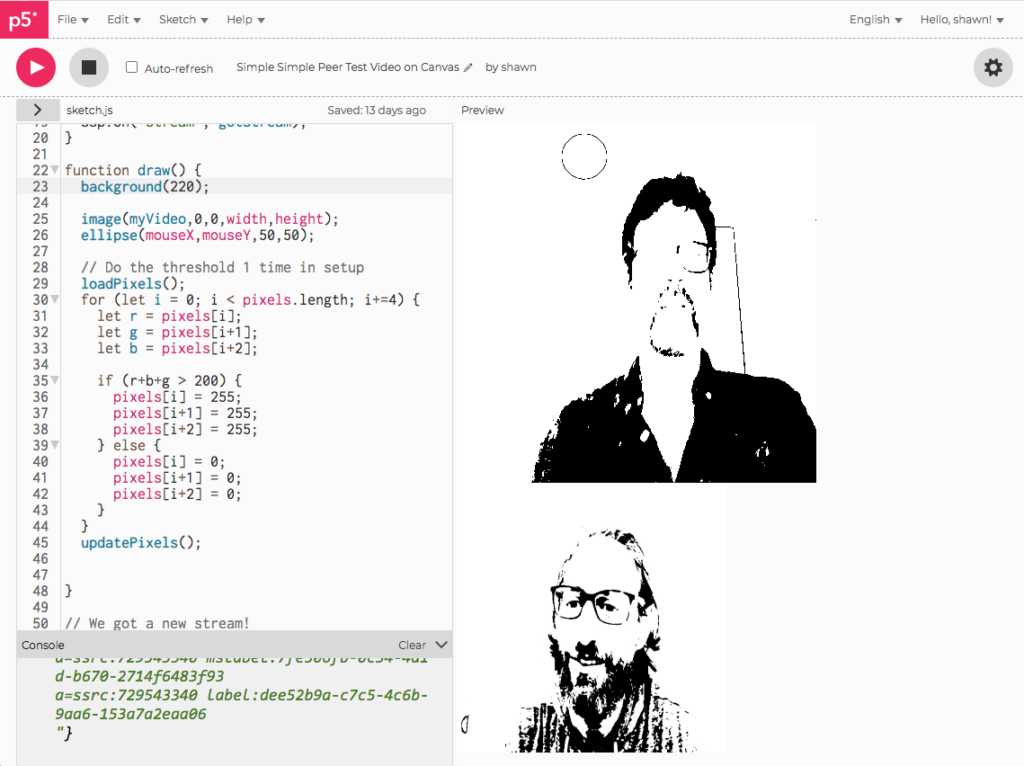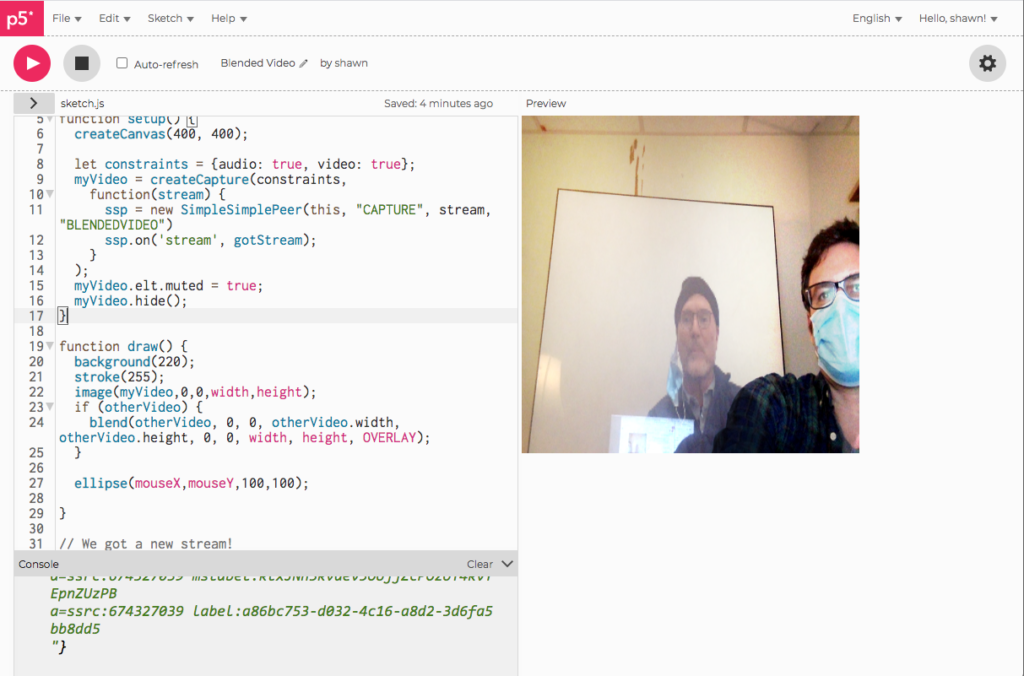p5LiveMedia is a new p5js library for sharing live audio, video, canvas (as video), and data between users.
Talking to Craig in a video thresholding example:

Talking to Dan in an overlay example:

p5LiveMedia is a new p5js library for sharing live audio, video, canvas (as video), and data between users.
Talking to Craig in a video thresholding example:

Talking to Dan in an overlay example:

A new blog post of mine on Make:

More Computer Science Isn’t the Answer
In class today, we talked quite a bit about the effects of computational media on society. I enjoyed the conversation we had about the push for driverless cars which stood as a stand-in for technological progress as a whole.
It would seem that driverless cars as nothing but beneficial, they would save lives, free us from wasted time, and so on. The longer term effects often go unexamined and might not be all that we hope for though. These would likely include longer commutes since we aren’t stuck doing the driving we may choose to live further away. As people are able to move further from work, cities, this would also cause more widespread environmental damage. The more time people spend in cars, they will be more isolated, exercise less, and create more pollution.
Will self driving cars partially solve one problem and end up causing more?
“who gets your phone when you die?”
She wasn’t specifically talking about my phone, more in the abstract, who gets anyone’s phone when they die. The phone to her is this all in one magical device that contains memories and connections, it contains all of the important pictures and is the quickest way to talk to everyone we care for.
Of course, she would wonder who gets so much of us when we die…
In 2007 and 2008, I worked on a project called vLinkr. What follows is a write-up of the initial idea and a few screen caps from the prototype.
vLinkr.com
vLinkr’s mission is to enable online media publishers abilities on-par with YouTube and Brightcove while hosting media on their own server on their own terms.
To this end, vLinkr is developing a suite of open source audio and video publishing tools that integrate with popular open source content management systems (initially WordPress and Drupal). Since these tools will be open source, it is hoped that others will help to improve and extend these tools in both functionality and platform reach.
Serious yet small media publishers are under-served by video sharing sites along the lines of YouTube. YouTube in particular is geared towards lower quality, extremely short, often copyright infringing media. Many of these sites follow suit and furthermore retain rights to re-use the media which can be problematic.
On the other side of the spectrum exist companies such as Brightcove whose products are geared towards high end media producers. These tools offer significantly more functionality in the management and control the publishing of online media that larger media companies require. Unfortunately, these tools and services involve significant cost that is often beyond the reach of small media publishers. Also, these tools are often not on the forefront of available technical and social capabilities, rather focusing on generating additional revenue for existing media assets.
vLinkr’s suite of tools seeks to offer a no-compromise solution that is both packaged and open source. (Support and professional services may well enter into this mix.)
Along with the features offered by social media sites (sharing, cross-posting, podcasting, transcoding, ad insertion and commenting) vLinkr seeks to help invent a new type of online media involving audio and video.
The features that currently exist on social media sites can be thought of as retrofits of existing “Web 2.0” technologies onto audio and video content. Unfortunately, these features surround the content rather than integrate with the content. A large part of vLinkr’s mission will be to prototype and release technology that seeks to crack open audio and video and help to make it parse-able, internally searchable and generally more internet like than television/radio like. vLinkr seeks to make audio and video on the internet more than just audio and video on the internet.
One issue with the type of distributed media publishing that vLinkr seeks to support (as opposed to aggregated publishing such as occurs on sites like YouTube) is that the media and is not indexed as well which can make it less “findable”.
This leads to the second portion of vLinkr’s service which is a centralized media data aggregation service. Using existing content syndication and content update infrastructure (RSS and pingback), this service will index most major online media publishing sites along with any individual media site that someone wishes to be added. Additionally, it will leverage the enhanced capabilities of the vLinkr publishing tools increasing the available metadata (audience viewing behavior, comment indexing and so on). These enhanced capabilities will attempt to be standardized so that other developers of publishing tools may generate this enhanced metadata and submit this enhanced metadata as well.
This data aggregation service while offering search and browse capabilities is not intended to be a destination or gateway site, rather it will be primarily used to offer a second set of tools that a media publisher may use on their site to offer search and related content. This will bring the capabilities available more in-line with those offered on existing social media sites and making distributed media more “findable”.
vLinkr believes that competitors in this space (Google Video, Blinkx, MeFeedia, Yahoo Video and so on) make the mistake of bringing the indexed content into their site. vLinkr believes this is somewhat unethical and may be considered copyright infringement. vLinkr, on the other hand will not display the media rather it will just index and link to it therefore helping those using vLinkr tools (and compatible tools) make their media more relevant and findable.
The centralized vLinkr service will have significantly lower infrastructure needs than it’s competitors and will be able to move quickly towards enhanced capabilities not having to house and transcode the media itself.
In terms of capital generation, this data in aggregated form may be sold to advertisers, marketers, media researchers and other interested parties. It may also be used to help target ad placements in content generated by vLinkr users should those users decide to allow advertising.
Any and all feedback or inquiries are encouraged and appreciated.
“We’ve got to make face-to-face time sacred, and we have to bring back the saying we used to hear all the time, and now never hear, ‘Look at me when I talk to you.”
via Clifford Nass, Researcher on Multitasking, Dies at 55 – NYTimes.com.
Having recently had a chance to get hacky with Google Glass, I put together an app that I have been wanting for quite a while. For now it is called Circular Buffer. Essentially it is a 15 to 20 circular frame buffer (Glass camera preview frames). Taping on the “Save” button writes out the frames to an MP4 with H.264 video using JavaCV giving you a video file with the last 15 or 20 seconds #throughglass. (Right now the video files do not have sound and are stored on the “sdcard” of the device. That means that you have to connect via USB and use the “adb” tool to download the files.)
This is a “native” Android app rather than the approved of method of writing Glass apps using the Mirror API. In order to use it, you have to either launch it through the Android developer tools (adb) or install “launchy” (https://github.com/kaze0/launchy).
Interested in trying it out or building on it, go for it: https://github.com/vanevery/Circular-Buffer.
Gargoyles represent the embarrassing side of the Central Intelligence Corporation. Instead of using laptops, they wear their computers on their bodies, broken up into separate modules that hang on the waist, on the back, on the headset. They serve as human surveillance devices, recording everything that happens around them. Nothing looks stupider; these getups are the modern-day equivalent of the slide-rule scabbard or the calculator pouch on the belt, marking the user as belonging to a class that is at once above and far below human society.
Destined for the MoMA Design Store!